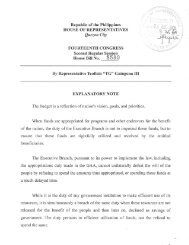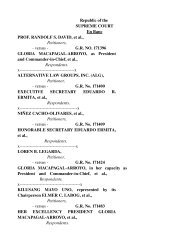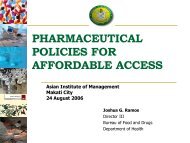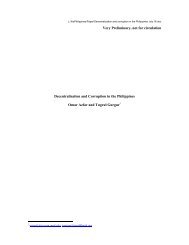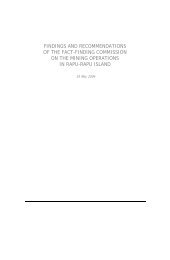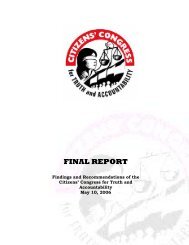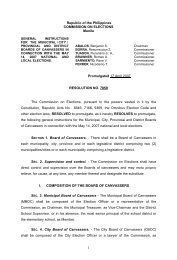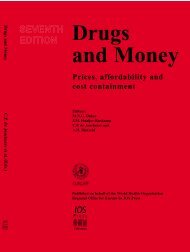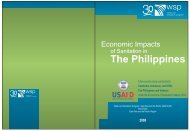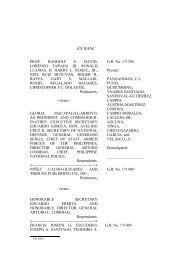i Report Issue No. 3 2005 - Philippine Center for Investigative ...
i Report Issue No. 3 2005 - Philippine Center for Investigative ...
i Report Issue No. 3 2005 - Philippine Center for Investigative ...
You also want an ePaper? Increase the reach of your titles
YUMPU automatically turns print PDFs into web optimized ePapers that Google loves.
For Visayans, the<br />
center does not hold<br />
RESIL B. MOJARES<br />
T<br />
HE IDEA of a Fed-<br />
eral Republic was<br />
already raised at<br />
the time of the <strong>Philippine</strong><br />
Revolution.<br />
In 1898, when the<br />
Aguinaldo government<br />
had not yet established its<br />
presence in the Visayas, leaders<br />
in Iloilo took the initiative of<br />
<strong>for</strong>ming “The Federal State of<br />
the Visayas,” anticipating the<br />
<strong>for</strong>mation of a federal republic<br />
with three states: Luzon, Visayas,<br />
and Mindanao.<br />
In 1899, a group of “eminent<br />
Filipinos” submitted to the US<br />
<strong>Philippine</strong> Commission a draft<br />
<strong>for</strong> a Federal Republic of the<br />
<strong>Philippine</strong>s, which proposed<br />
to divide the country into 11<br />
regions or states. In 1900, the<br />
maverick Ilocano intellectual<br />
Isabelo de los Reyes also published<br />
a proposal <strong>for</strong> a federal<br />
constitution that would divide<br />
the country into seven states.<br />
These ideas were not developed<br />
because of the Aguinaldo<br />
government’s need to create a<br />
unitary state with strong central<br />
powers to fight a war. The federal<br />
alternative was also rejected by<br />
the US <strong>Philippine</strong> Commission<br />
(on the grounds of Filipino<br />
unpreparedness <strong>for</strong> the system)<br />
and the idea was completely<br />
swamped as the United States<br />
consolidated its rule and set the<br />
country on track toward a unitary<br />
<strong>for</strong>m of government. The<br />
goal of federalism, however, has<br />
persisted as a recurrent theme<br />
in debates on the best structure<br />
of government <strong>for</strong> the country.<br />
In the 1971 Constitutional<br />
Convention, <strong>for</strong> instance, the<br />
shift to a federal system was<br />
strongly supported by many of<br />
the Muslim delegates as well<br />
as other Christian and Muslim<br />
leaders and intellectuals. In the<br />
1980s, Reuben Canoy’s Mindanao<br />
Independence Movement<br />
proposed a “Federal Republic<br />
of Mindanao” and produced as<br />
part of its propaganda campaign<br />
a constitution, passports, and the<br />
Mindanao dollar.<br />
The accumulation of experiences—enabling<br />
as well as disabling—under<br />
the 1991 Local Government<br />
Code and the creation<br />
of autonomous regions has built<br />
a consensus that decentralization<br />
GOING FEDERAL. Those living<br />
in the country’s periphery,<br />
like these Negros sugarcane<br />
workers, have always felt<br />
neglected by “imperial” Manila.<br />
has to be pushed <strong>for</strong>ward. There<br />
are those who hold the view of<br />
“maximum decentralization short<br />
of federalization” and there is<br />
genuine anxiety over the prospect<br />
of such a radical structural shift<br />
as federalization. There is lack of<br />
consensus about the exact shape<br />
of federalism to be adopted, and<br />
the discourse has stayed largely<br />
at the level of leaders rather than<br />
among the people themselves.<br />
Yet federalism has moved<br />
clearly to the center of discussions<br />
on constitutional re<strong>for</strong>m.<br />
It has become even more urgent<br />
because of today’s crisis at the<br />
center. At no other time has the<br />
level of public frustration about<br />
how our unitary presidential<br />
system works been highest as<br />
now. Disillusion with the system<br />
is such that there are leaders in<br />
Davao, Cebu, and the Ilocos who<br />
have publicly declared that if<br />
the present crisis in Manila spins<br />
out of control, their respective<br />
regions will “withdraw” from<br />
Manila and declare their “independence.”<br />
This is not just political<br />
theatrics but an expression of<br />
deep frustration over the central<br />
government. This has made federalism<br />
a vital concern.<br />
A CENTRAL VISAYAN<br />
STATE<br />
Central Visayas may be among<br />
the best positioned <strong>for</strong> a transition<br />
to a federal state. This is<br />
because it is a fairly definable,<br />
self-conscious unit on linguistic<br />
cultural (high degree of homogeneity<br />
in language and religion),<br />
geographic (it is internally well<br />
connected), economic, and political<br />
grounds.<br />
Cebu, the region’s de facto<br />
capital, has a tradition of local<br />
autonomy supported by such<br />
factors as geographic location<br />
(distance from Manila, strategic<br />
location in the South), cultural<br />
difference (chiefly, language),<br />
and economic and political base<br />
(southern economic hub, Cebuano<br />
cultural “homeland”).<br />
Its leaders have built on Cebu’s<br />
reputation as a rival center<br />
to Manila and styled themselves<br />
political vanguards of “local autonomy.”<br />
This is clearly illustrated<br />
by the Osmeñas, the region’s most<br />
influential and enduring political<br />
family. In the early 20 th<br />
century,<br />
when unitary state-building was<br />
the imperative, Sergio Osmeña<br />
Sr. styled himself as the “apostle<br />
of national unity.” In the postwar<br />
period, when the inefficiency<br />
of central government was the<br />
popular lament, Sergio Osmeña Jr.<br />
(gearing up <strong>for</strong> a national position<br />
as chair of the League of Provincial<br />
Governors and City Mayors in<br />
1957) billed himself “champion<br />
of local autonomy.” With the<br />
distrust of central government<br />
heightened by the experience of<br />
martial rule and the perceived<br />
weakness of the post-EDSA governments,<br />
other Osmeñas put<br />
themselves at the <strong>for</strong>efront of the<br />
local autonomy movement. In<br />
1991, Emilio ‘Lito’ Osmeña, running<br />
<strong>for</strong> vice president under Fidel<br />
Ramos’s Lakas-NUCD, <strong>for</strong>med the<br />
Local Autonomy Movement of the<br />
<strong>Philippine</strong>s. In the same election,<br />
his brother John, also eyeing the<br />
vice presidency (later settling<br />
<strong>for</strong> a senatorial seat), <strong>for</strong>med a<br />
registered political organization,<br />
Pilipinas 1992, that advocated<br />
federalism.<br />
Yet while the relation between<br />
the region and the center<br />
is contested, the discourse on<br />
politics in the region has always<br />
been one of local power in the<br />
context of the unitary state. The<br />
region has never harbored a<br />
secessionist movement; it is the<br />
seat of what may be called “conservative<br />
anti-centralism.”<br />
26 PHILIPPINE CENTER FOR INVESTIGATIVE JOURNALISM I REPORT



